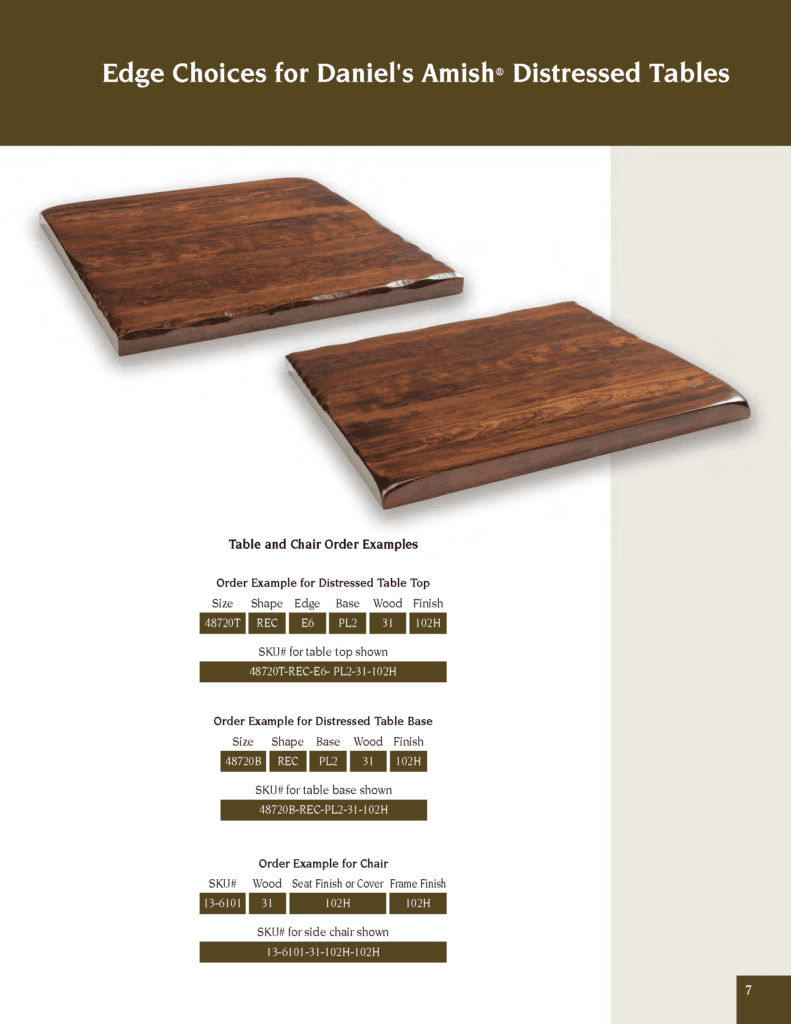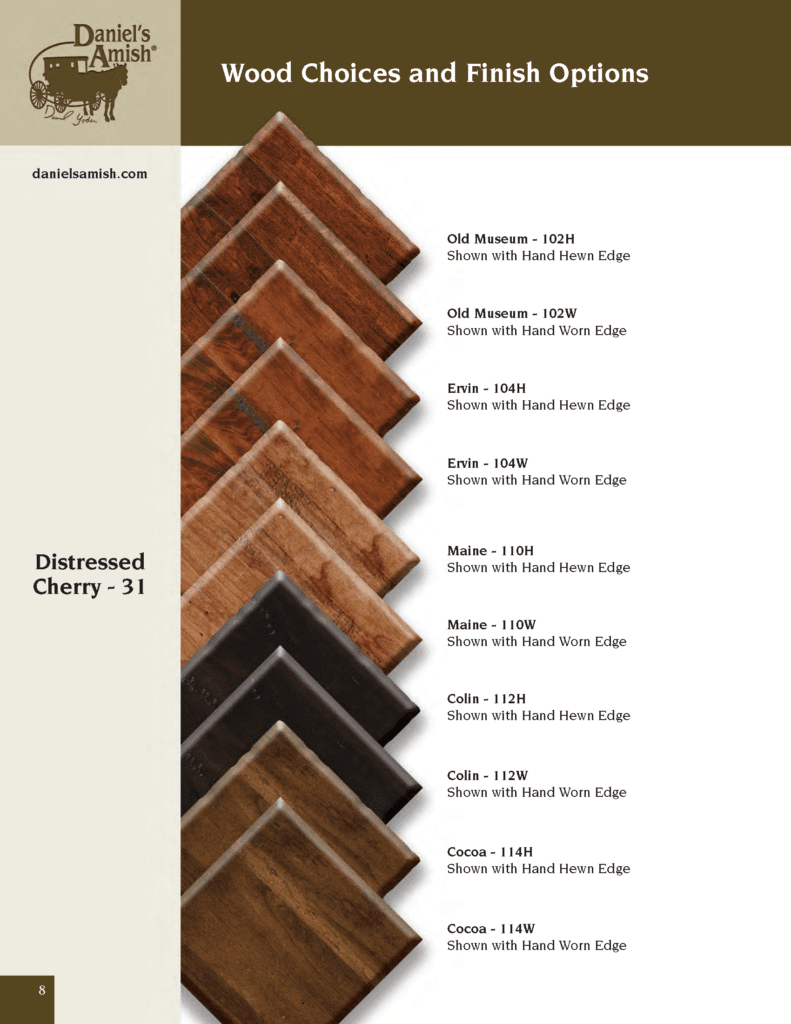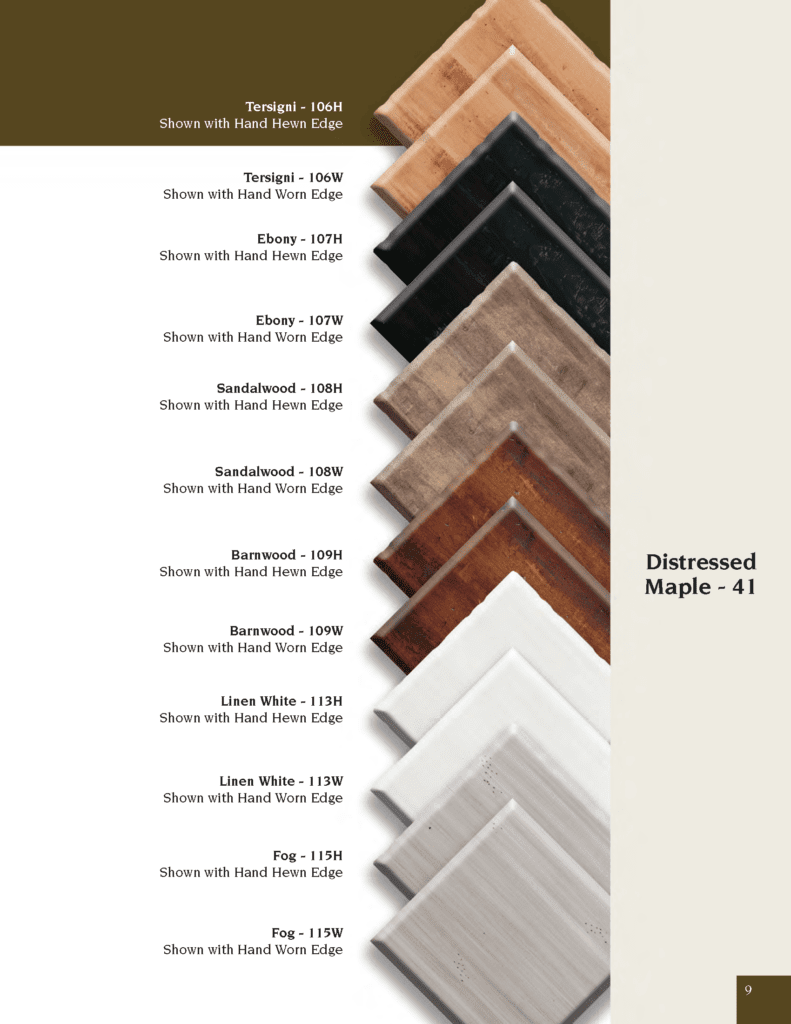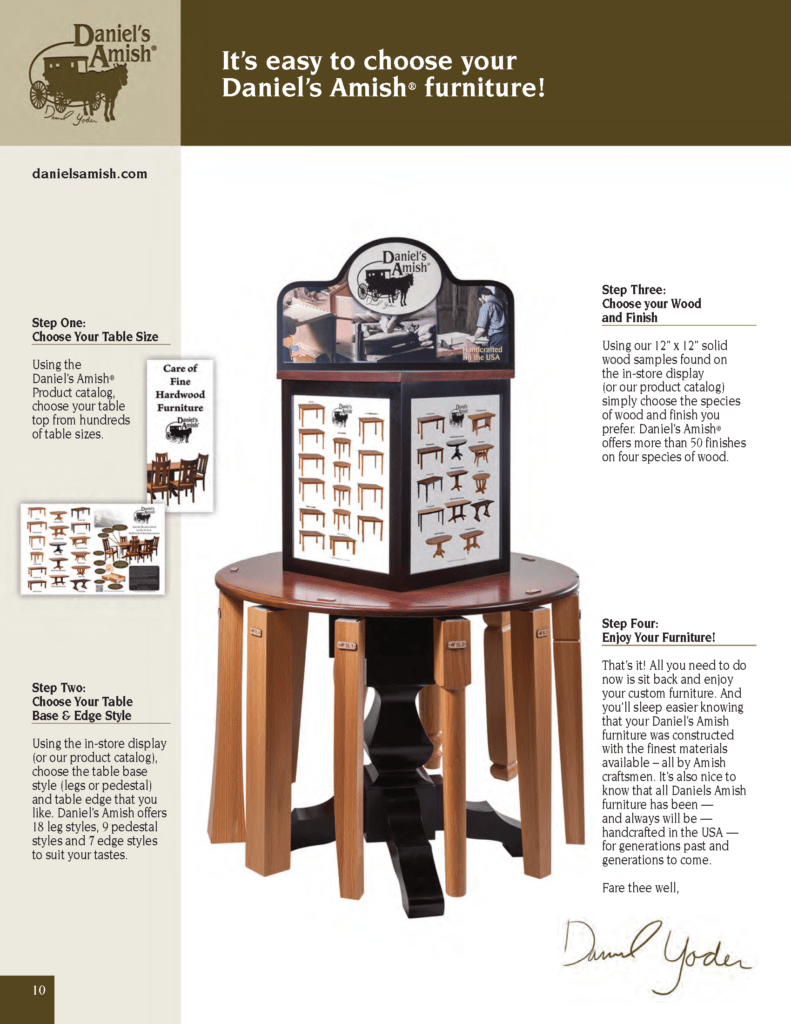Amish Dining

Four Wood Species
 All dining furniture is available in Oak, Cherry, Maple and Quartersawn White Oak.
 Distressed finishes are available in Cherry and Maple.
 Pricing step ups for Tables and Casegoods are Oak, Cherry/Maple, QS White Oak .
 Pricing step ups for Chairs are Oak, Maple and Cherry/QS White Oak.
Tables
Leg tables can be ordered as solid tops and with up to 12 leaves. Leg tables ordered with leaves utilize a sturdy all-wood slide and can self-store up to 4 leaves as specified on each table page. A 5th leg center support is included on all tables 72″ in length (before leaves are added) and on shorter tables when 3 or more leaves are specified. A 6th leg center support is provided when 8 or more leaves are ordered.
 Pedestal tables are constructed with single or, when required based on shape and length, double geared slides. They are designed to hold up to 4 leaves.
 All Not Self-Storing leaves will come with aprons.
 Some leaves are provided without aprons for self-storing purposes as noted in the table description. Aprons can be added to these leaves at no charge, but this will affect number of leaves that can be self-stored. Please specify the addition of aprons when ordering.
 Table locks are installed when there is sufficient space between the aprons and slides as determined by table size and shape. Please refer to the DAC Table Lock Guide to determine whether locks are installed on a specific table.
 Custom widths may be special ordered, provided they are wider than 36″. The price is determined by the next wider standard size available as shown in the price list.
 The bottoms of all tables are sprayed with a wood stabilizer to help prevent cracking and warping.
 Table tops and leaves are carefully selected for best wood grain and color match. However, variation in hard woods is expected and contributes to the natural beauty. Lighter stains will show greater variation, including mineral streaks and deposits, small knots, and tiny pitting, all of which are normal and expected.
 Tables should be kept in a humidity range between 35° – 45° to help prevent cracking and warping. Do not place tables close to a heat source or outlet.
 Leaves are carefully hand-fitted during production. Additional leaves cannot be ordered once the table is produced.
Wood Finishes
 Wood species are available only with the specific stains shown in the catalog and in the design center.
 NOTE: A stain from one wood species may NOT be used on a different wood species.
 Once the wood species is selected, the price remains the same for each of the stains for that specific wood species.
 Painted stains are available ONLY on Maple or Oak with a 10% UPCHARGE.
 Painted finishes are NOT available on table tops.
There is no upcharge for two-tone stains on dining furniture from Daniel’s Amish® Collection. We are confident that you and your customers will take full advantage of this opportunity to create beautiful and unique dining room furnishings.
Hardwoods, also known as deciduous trees, usually produce a fruit or a nut and lose their broad leaves every Fall. Oak species are the most common, representing more than 50% of all hardwood trees in North America. Quarter sawn lumber, as its name suggests, refers to a speci fic way of rip cutting, or sawing, logs lengthwise. In traditional plain or at sawing, the log remains in the same orientation as it is cut into individual boards. When quarter sawing, the log is split in half, then rotated and cut into quarters which are then sliced perpendicular to the growth rings. The result is extra sturdy planks with tight, parallel grain lines running lengthwise and showing characteristic ray flecks. Quarter sawn white oak lends traditional authenticity, especially to Arts & Crafts and Mission furniture. Antique Cherry, with its beautiful grain patterns and rich coloring, is one of the most desirable wood species for furniture. Variations in individual planks, like tiny knots, pits, mineral streaks and deposits, enhance
the natural beauty of handcrafted cherry wood furniture and make each piece unique.
Please note carefully the following details:
1 All tables may be ordered with two different stains, one for the top and the other for the base,
at no additional cost, provided the wood species are priced the same.
2 All chairs currently available in two-tone (as noted in the catalog on both the color and pricing
pages) may be ordered with two different stains, one for the seat and the other for the frame,
at no additional cost, provided the wood species are priced the same.
3 All case pieces, hutches, buffets, and sideboards can be ordered with two different stains, at no additional cost, provided the wood species are priced the same. Doors, drawer fronts, and tops will be finished in one stain while the frame will be finished in the second stain as specified. With the exception of the Classic Buffet. The top will be in one stain and the frames, drawers and drawer fronts will be in another stain unless specified.
4 Two-tone combinations specifying both distressed and non-distressed STAINS are NOT available.
Distressed pieces CAN be ordered with painted Maple bases and frames for a 10% upcharge.
See Distressed section for additional details.
5 Tables, chairs, and case pieces ordered with two different wood species in order to specify a particular stain combination will be charged at the cost of the more expensive wood when there is a difference. When ordering chairs or case pieces, please specify the higher priced wood species when there is a difference since this determines the price. Please see example below.
6 Chairs ordered with a fabric, vinyl, or leather seat cannot be ordered in two-tone. Standard
upcharges for upholstery will apply.
7 There is still a 10% upcharge for painted Maple and Oak finishes. Please see example below.
Examples:
Use of two different wood species: A customer wishes to order a dining table, chairs, and buffet in a two-tone Cherry and Maple combination. The higher priced of the two wood species should be used. For the chairs, since the Cherry price is higher than Maple, the Cherry price should be applied. For the table and buffet, the Cherry and Maple prices are the same, so there is no price difference for this combination of wood species. There is no upcharge for applying two different stains.
Painted tables and chairs: A customer wants to order a Cherry table with a stained top and painted base (must be Maple) and Cherry chairs with stained seats and painted frames (Maple). The higher price of the two wood species should be used which in this case is Cherry. To determine the price, add a 10% upcharge to the standard price for these items in Cherry. When ordering chairs and case pieces, please specify the higher priced wood species when ordering since this determines the price. Note that painted pieces are always in Maple.
Dining Distressed Program
All tables, benches, stools, and case pieces and nearly all chairs can be ordered distressed on carefully selected finishes in Cherry and Maple for a modest upcharge. Compared to the previous Rustic program, this provides far more choices and much better value for customers.
Please note that these instructions MUST be closely followed when ordering distressed tables and chairs. Distressed dining pieces are available only with specific stains on Distressed Cherry (31) and Distressed Maple (41) as shown in the catalog or with painted Maple two-tone combinations as shown below. Only the Hand Hewn (E6) and Hand Worn (E7) edge treatments are available.
Program Details – Selection and Pricing
1 Select ANY table with 4 leaves or less, find the price for Cherry & Maple, and add the upcharge shown at the bottom of the price page to determine the distressed price. After the 4th leaf, please add the upcharge shown at the bottom of the page for each additional leaf.
2 Select any chair or any barstool, find the price in Maple or Cherry, and add the
upcharge shown at the bottom of the price page.
3 Select any bench, including extendable versions, find the price in Cherry & Maple,
and add the upcharge shown at the bottom of the price page.
4 Select any hutch, find the price in Cherry & Maple, and add the upcharge shown at
the bottom of the price page to determine the distressed price.
5 Select any buffet or sideboard, find the price in Cherry & Maple, and add the
upcharge shown at the bottom of the page to determine the distressed price.
6 Select any combination hutch and buffet (corner unit), find the price in Cherry &
Maple, and add the upcharge shown to determine the distressed price.
- Tables. Any table in the DAC dining table catalog can be ordered distressed.
- Chairs, Benches, Barstools. Any chair, bench, or barstool, can be ordered distressed. Distressed chairs CAN be ordered with upholstery when fabric selections are available as shown on each chair page.
- Case Pieces. Any hutch, buffet, or sideboard can be ordered distressed.
- Distressing. DAC craftsmen artfully custom distress every table and chair by hand to ensure natural variation. In addition to the elegant “rolling hand planing” technique on table tops, the distressing treatment includes the addition of “worm holes,”dings/dents, and, occasionally, small naturally occurring knots.
- Edge Profile. Distressed table edges and chair seats and frames receive either the more heavily distressed hand hewn (E6), or less distressed hand worn (E7), edge treatment as ordered. No other edge profiles can be ordered on distressed items.
- Wood Species. Distressed dining furniture is offered only in Distressed Cherry (31) and Distressed Maple (41) or with painted Maple two-tone combinations as specified below. Non-distressed finishes on other wood species are NOT available.
- Finishes. Distressed finish codes have changed and now include either H (Hand Hewn) or W (Hand Worn) to specify the edge treatment. Finish codes must include H or W to ensure order accuracy.
- Two-tone combinations with two distressed finishes. Two-tone combinations specifying two different distressed Cherry or Maple finishes are available. While there is no specific upcharge for two-tone combinations, when a Cherry and Maple combination is specified, chairs, barstools, and most benches will be charged at the higher Cherry price. Tables and case pieces are priced the same in Cherry and Maple so a single price applies. See the two-tone section on the previous page for additional detail.
- Two-tone distressed combinations with painted bases and frames. Two-tone combinations specifying distressed finishes and painted bases or frames are available. Table tops, chair seats, bench tops, and case piece doors, drawer fronts, and tops must be in an available distressed finish. Table bases and legs, chair frames, bench legs, and case piece frames must be in an available painted Maple finish and will NOT be distressed. A 10% upcharge will be added to the distressed price for each piece.









